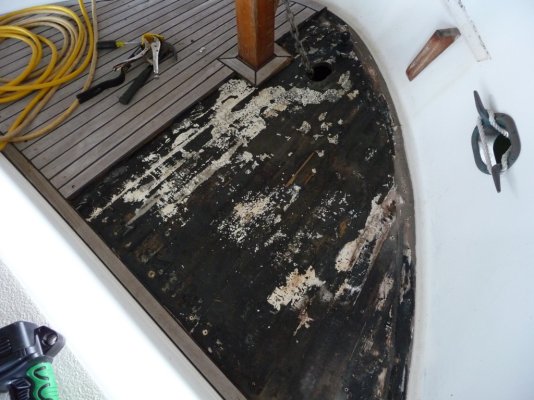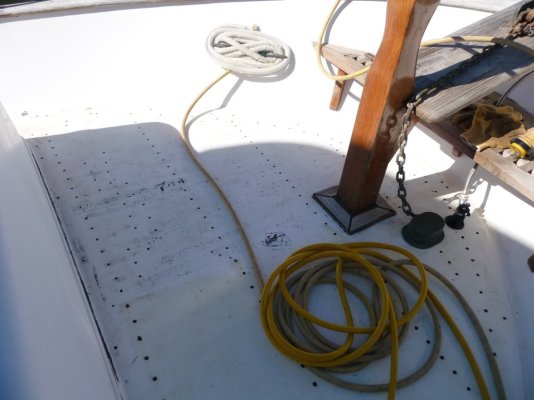Phil Fill wrote:
*
.....and reseal the dock with Dallys Seafin Teak oil, which takes a couple of hours spread over several days to let things dry/cure.
This is actually not a very good idea.* Putting an oil finish on a teak deck hastens its demise.* The wood doesn't need the oil, so you're not doing it any favors by putting oil on it.* In fact the oil can help break down the bond between the deck seams and the wood on either side of them.* The other thing oil does do is trap dirt, soot, etc.* Then as you walk around on the deck, this combination turns into a very effective cutting compound and you gradually wear away the upper cells of the wood as you walk.* And the wood you wear away you can't get back.
The deck on our boat is original, and is the "eye candy" planking as described by FF.* So it wasn't very thick to begin with and previous owners had sanded away too much of it. * At least half the plugs were missing when we bought the boat and in some spots, the bottoms of the grooves were even with the tops of the planks.* But a shipwright we knew at the time determined there was still enough wood to work with.* So he stripped out all the old seam compound, re-grooved the* main deck (by hand), and re-seamed it.* This was about ten years ago.
The only things we do to the deck are replace plugs that come out (usually the very thin remains of the ones that were still there when we acquired the boat), and repair seams that pull away from one side of the groove in high-use areas.*
On the advice of several shipwrights we've talked to over the years and on some of the better wood care books I've read, the only thing we do to the wood is keep it clean.* So every few weeks we mop the deck down with cold salt water (never fresh water) and Lemon Joy.* Joy is recommended because it makes good suds in cold water.* We use a regular string mop for this.
Then* two or three times a year we give the deck a little stronger cleaning with the same salt water/Lemon Joy mixture but we use a 3M doodlebug pad LIGHTLY on the deck, always going across the grain except where deck hardware makes this impossible.
The "rules" regarding the care and feeding of teak decks that I've collected over eleven years of taking care of a teak deck that was already 25 years old when we bought it are:
*NEVER power wash it.* Ever.
*Keep it clean with salt water and a sudsing detergent.* Use only a string mop, sponge mop, or very soft brush.
*NEVER scrub a teak deck in the direction of the grain except in places where deck hardware prevents going across the grain.* Going with the grain is okay only with a string mop or sponge mop.
*Maintain the integrity of the seam sealant.* (Use TDS---Teak Decking Systems--- sealant, it's superior to any other deck sealant on the planet these days).* Seams that have pulled away from one side of the groove do not have to be stripped out completely but can be repaired using the "45 degree cut" method.
*When redoing a seam completely, make sure to use a bond-breaker in the bottom of the seam.* The material most often used is 3M automotive striping tape.* The prevents the sealant from adhering to the bottom of the groove, so as the wood works from being walked on and expanding and contracting as Phil described, the sealant will flex but remained adhered to the sides of the groove, which is where you want it to stay.* If the sealant adheres to the bottom of the groove, it is just a matter of time before one side or the other will pull away from the wood and moisture will be able to get in.* Also, always thoroughly clean the inside of the groove with acetone before applying new sealant.* This removes the natural oil from the wood so the sealant will adhere better.* (One reason you don't want to be putting any oil on your deck.)
*Replace any plugs that come out asap.
*Re-seat/seal the deck screws that are exposed when a plug comes out before replacing the plug.
*Never oil a teak deck.
*Never apply a "looks good" finish like Cetol, varnish, Deks Olje, etc. to a teak deck.
*Never use a so-called teak cleaner/restorer.* The only way to make a teak deck turn brown again is to remove the weathered gray wood cells in the top layers.* There are two ways to do this--- sandpaper and teak cleaner.* Teak cleaners simply do what sandpaper does only they do it chemically.* Either way, wood goes away and you can't get it back.* And the newly exposed, pretty brown wood cells will weather to gray in a few weeks, so you'll end up using the teak cleaner again and more wood will go away.*
A 120' corporate yacht I was associated with for awhile "went through" its exterior main deck teak planking every eight years or so.* This was because part of the requirement for the boat's appearance was to have a new-teak-colored deck (the yacht was part of the owning company's marketing department and was used with customers year-round). * So the crew used teak cleaner on a regular basis. The yacht's captain, crew, and corporate owner were well aware of the penalty of doing this, and the increcibly high cost of replacing the main deck planking was factored into the operating cost of the yacht
If you keep the deck covered, either with canvas or in a boathouse, the brown color will last a lot longer.* But if your boat is kept outside with no cover, a newly sanded or chemically stripped teak deck will weather back to gray very quickly.* Example--- Our boat is kept outside and has a full cover over the flying bridge.* Since we never run the boat from up there, the flying bridge deck stays covered virtually year round.* It's deck planking is still brownish, and was when we bought the boat eleven years ago.* Our main deck is the normal silver/gray.
The cost of replacing a teak deck on a 36' boat as of a few years ago varied between $20,000 and $30,000 depending on who the bid was from.* Given the skyrocketing cost of good teak (as opposed to the not-as-good plantation teak) these day, the cost has probably near doubled since then.* The upside of replacing a teak deck today is that it can be glued down instead of screwed down.* The teak decks on Grand Banks, Fleming, etc. are all glued down now.* So no screw holes.
Teak is a fabulous deck surface, far better in my opinion, than fiberglass or any other material in terms of traction, wet or dry.* It does get hot in the sun in warm climates if you're a person who likes to boat in bare feet.*
*So, finally, if you want to avoid the cost of replacing a teak deck, or avoid the major hassle of removing one and applying a solid, well-finished fiberglass deck in its place, learn to love the color silver/gray
-- Edited by Marin on Tuesday 3rd of November 2009 01:01:40 PM

